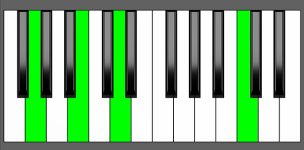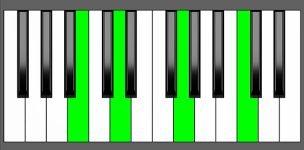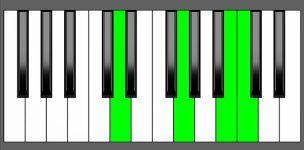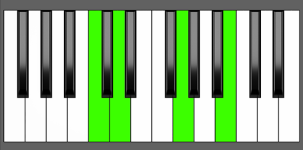Piano Diagram of G add11 in Root Position
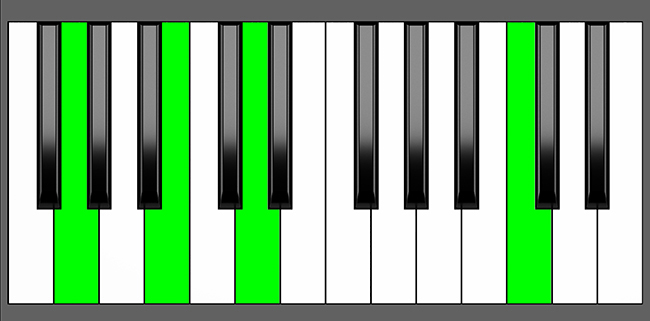
The G add11 chord is a G Major (G, B, D) with an extra 11th note (C). It’s an added tone chord, meaning that it’s built by adding an extra interval to a triad. Keep reading to gain a deeper understanding of the music theory behind this chord.
Structure of G add11
Notes |
|---|
| G, B, D, C |
Intervals |
|---|
| R, 3, 5, 11 |
Playing Extended Chords on Piano
Extended chords are challenging to play in their entirety on the piano due to the high number of notes involved, or the wide intervals between them like in the case of add 11th chords.
To simplify these chords, pianists may omit certain notes, typically the root or fifth, or divide the chord between both hands.
G add11 Chord Inversions
G add11 chord has a total of 3 inversions:
| Root Position: | G | B | D | C |
| 1st Inversion: | B | D | G | C |
| 2nd Inversion: | D | G | B | C |
| 3rd Inversion: | C | D | G | B |
Piano Keyboard Diagrams
Chord Inversions on Piano
Chord inversions are a crucial concept in music theory as they allow for a greater understanding of how chords are constructed and how they can be used in progressions.
However, it’s important to note that the diagrams depicting the sequence of notes in a chord inversion on a piano keyboard may not always translate to practical playing. This is because proper chord voicings involve distributing the notes of the chord across different octaves and positions on the keyboard, which may differ from the basic shape of the chord’s inversions.
Therefore, while chord inversion diagrams help understand the structure and sequence of notes in a chord, they may not always be the most efficient way to play the chord on a piano keyboard.
Music Theory and Harmony of G add11
Building the G add11 Chord: Different Approaches
Starting from the G Major Scale:
To build an add11 chord, you can use the Major scale as a reference by combining a Root, a 3rd, a 5th, and an 11th.


Apply the formula R, 3, 5, 11 to get a G add11 chord.
- Begin with the Root note, G.
- Select the 3rd note, B.
- Add the 5th note, D.
- Finally, include the 11th note, C, which is a 4th note but an octave higher.
by Combining Intervals:
To build an add11 chord, one approach is to combine specific intervals, namely a major 3rd, a minor 3rd, and a minor 7th.
3 + m3 + m7 = add11 Chords
For example, to make the G add11 chord, you can stack
- G-B (major 3rd),
- B-D (minor 3rd),
- and D-C (minor 7th) on top of each other.
How to Use G add11 in a Chord Progression
Music theory classifies chords based on their harmonic function, which can be categorized as either tonic, subdominant, or dominant chords. The G add11 chord, which can replace a regular G major chord, can have any of these functions, depending on its context in a composition
However, the 11th note (C) present in G add11 may not always fit with the scale being used. This means that the chord can introduce a non-diatonic tone that does not belong to either the D major or B minor scales.
For this reason, the use of the G add11 chord in these keys should be approached with caution to avoid dissonance or unintended clashes with the melody or the bass line. The use of non-diatonic chords should be intentional and targeted to specific musical effects.
The G add11 chord can serve as a tonic chord that resolves the tension created by a preceding dominant chord, such as D7. Alternatively, in a chord progression in the key of C major, it can also act as a dominant chord. In both cases, it’s common to use the add11 chord in chromatic or diatonic modulation. I will provide some examples of its use in chord progressions.
on Major Scales
| Major Scales | I | ii | iii | IV | V | vi | vii |
|---|---|---|---|---|---|---|---|
| G | G Maj7 ⇒ G add11 | A min7 | B min7 | C Maj7 | D7 | E min7 | F#m7b5 |
| D | D Maj7 | E min7 | F# min7 | G Maj7 ⇒ G add11 | A7 | B min7 | C#m7b5 |
| C | C Maj7 | D min7 | E min7 | F Maj7 | G7 ⇒ G add11 | A min7 | Bm7b5 |
- Tonic chord in G Major
- Non-diatonic Subdominant chord in D Major
- Dominant chord in C Major (less common)
on Natural minor Scales
| Minor Scales | i | ii | III | iv | v | VI | VII |
|---|---|---|---|---|---|---|---|
| E | E min7 | F#m7b5 | G Maj7 ⇒ G add11 | A min7 | B min7 | C Maj7 | D7 |
| B | B min7 | C#m7b5 | D Maj7 | E min7 | F# min7 | G Maj7 ⇒ G add11 | A7 |
| A | A min7 | Bm7b5 | C Maj7 | D min7 | E min7 | F Maj7 | G7 ⇒ G add11 |
- Mediant chord in E minor
- Non-diatonic Submediant chord in B minor
- Dominant chord in A minor (less common)
The Versatility of the 11th Interval in Music Composition
The 11th interval is generally considered a dissonant interval. However, the perception of consonance or dissonance can vary depending on the musical context and the listener’s personal preference.
In some cases, an 11th interval may be intentionally used to create tension and a sense of unresolved harmony. In other cases, it may be used as a stable chord or part of a modulation on a consonant degree.
G add11 Function in Major and Minor Keys
Understanding Scale Degrees
Harmonizing a scale involves creating chords using the notes from that scale. Each note in the scale is given a degree, which reflects its position in the scale.
The degrees of the diatonic major scale are as follows:
- Tonic: This is the first degree of the scale and serves as the primary tonal center or “home base” of the music. It creates a sense of resolution and stability.
- Supertonic: This is the second degree of the scale and often functions as a passing tone or a transitional note between the tonic and other scale degrees.
- Mediant: This is the third degree of the scale and helps to establish the overall tonality of the scale (major or minor). It sits halfway between the tonic and dominant notes.
- Subdominant: This is the fourth degree of the scale and is often used as a complementary harmony to the dominant.
- Dominant: This is the fifth degree of the scale and creates tension and a sense of expectation. It is usually resolved by returning to the tonic.
- Submediant: This is the sixth degree of the scale and sits halfway between the tonic and subdominant notes. It is often used as a transitional note between the dominant and the tonic.
- Leading tone: This is the seventh degree of the scale and sits one half step below the tonic. It creates a strong sense of tension and a desire to resolve to the tonic.
G add11 in G Major
The G add11 chord can be used instead of a G major or a G major 7th chord. In a major key, the I chord (built on the first degree) serves as the tonic chord, providing the harmonic center of the chord progression.
| I | ii | iii | IV | V | vi | vii |
| G Maj7 ⇒ G add11 | A min7 | B min7 | C Maj7 | D7 | E min7 | F#m7b5 |
G add11 Chord Progressions as I degree
Replacing a major chord with an add11 chord can add more color and interest to your music. The G add11 chord can be used as a variation of the tonic chord, or as an intermediate step to move to a more stable G major chord by lowering the 11th note by a half step.
ii V I
| ii | V | I |
||
| A min7 | D7 | G Maj7 | G Add11 | G Maj |
I IV V
| I | IV | V |
| G add11 | G Maj7 | C Maj7 | D7 |
I V vi IV
| I | V | vi | IV |
| G add11 | G Maj7 | D7 | E min7 | C Maj7 |
I IV vi V
| I | IV | vi | V |
| G add11 | G Maj7 | C Maj7 | E min7 | D7 |
G add11 in D Major (Non-Diatonic)
Another way to use the G add11 chord is as a substitution for the G Maj7 chord when it appears on the fourth degree of the D major scale. This can be used in the I-IV-V chord progression, where the add11 chord on the fourth degree acts as a transitional chord between the first and fifth degrees.
Note that the 11th interval C may clash with the Db note found in the D major scale, as they are a half step apart.
| I | ii | iii | IV | V | vi | vii |
| D Maj7 | E min7 | F# min7 | G Maj7 ⇒ G add11 | A7 | B min7 | C#m7b5 |
G add11 as IV degree – Chord Progressions
Play these chord progressions to hear how an add11 chord can be used as a substitute for the subdominant (IV degree) in a chord progression.
I IV V
| I | IV | V |
| D Maj7 | G add11 | G Maj7 | A7 |
I V vi IV
| I | V | vi | IV |
| D Maj7 | A7 | B min7 | G add11 | G Maj7 |
I IV vi V
| I | IV | vi | V |
| D Maj7 | G add11 | G Maj7 | B min7 | A7 |
G add11 in C Major
Another way to use the G add11 chord is as a variation of the dominant chord in the C major scale.
In this case, the G add11 chord functions as a variation of the G Major 7 chord, serving as the fifth degree of the C major scale. When used in a ii-V-I progression, the G add11 chord on the fifth degree can function as the dominant chord that resolves to the first degree.
While this may not be the most ideal use of the chord, as the 11th corresponds with the root of the first degree, it is still worth mentioning as a possible variation.
| I | ii | iii | IV | V | vi | vii |
| C Maj7 | D min7 | E min7 | F Maj7 | G7 ⇒ G add11 | A min7 | Bm7b5 |
G add11 as V degree – Chord Progressions
You can try playing these chord progressions to hear how the G add11 chord works as a substitute for the subdominant (IV degree) in a chord progression:
ii V I
| ii | V | I |
| D min7 | G add11 | G7 | C Maj7 |
I IV V
| I | IV | V |
| C Maj7 | F Maj7 | G add11 | G7 |
I V vi IV
| I | V | vi | IV |
| C Maj7 | G add11 | G7 | A min7 | F Maj7 |
I IV vi V
| I | IV | vi | V |
| C Maj7 | F Maj7 | A min 7 | G add11 | G7 |
I IV ii V iii vi ii V
| I | IV | ii | V | iii | vi | ii | V |
| C Maj7 | F Maj7 | D min7 | G add11 | G7 | E min7 | A min7 | D min7 | G add11 | G7 |
G add11 in E minor
In the E minor key, the add11 chord can also be used as a substitute for the G Maj7 chord as the third degree.
| i | ii | III | iv | v | VI | VII |
| E min7 | F#m7b5 | G Maj7 ⇒ G add11 | A min7 | B min7 | C Maj7 | D7 |
G add11 as III degree – Chord Progressions
These chord progressions show G add11 as a variation of the mediant (III degree) chord.
i III
| i | III |
| E min7 | G add11 | G Maj7 |
i III VII VI
| i | III | VII | VI |
| E min7 | G add11 | G Maj7 | D7 | C Maj7 |
Circle Progression
| i | iv | VII | III | VI | vii | V7 | i |
| E min7 | A min7 | D7 | G add11 | G Maj7 | C Maj7 | F#m7b5 | B7 | E min7 |
G add11 in B minor (Non-Diatonic)
Another situation where the G add11 chord can be used as a variation is in the key of B minor. As previously mentioned in the context of the D major key, the 11th note (C) is not diatonic to the B minor scale.
Therefore, using the G add11 chord as a submediant chord in B minor would introduce a non-diatonic element to the chord progression. However, this can also create a unique and interesting sound that can be utilized in a musical composition.
| i | ii | III | iv | v | VI | VII |
| B min7 | C#m7b5 | D Maj7 | E min7 | F# min7 | G Maj7 ⇒ G add11 | A7 |
G add11 as VI degree – Chord Progressions
You may want to experiment with these chord progressions to understand how G add11 can be used instead or in conjunction with a G Maj7 chord when it acts as the submediant (VI degree) in B minor.
i VI VII
| i | VI | VII |
| B min7 | G add11 | G Maj7 | A7 |
i v VI VII
| i | v | VI | VII |
| B min7 | F# min7 | G add11 | G Maj7 | A7 |
i III VII VI
| i | III | VII | VI |
| B min7 | D Maj7 | A7 | G add11 | G Maj7 |
Circle Progression
| i | iv | VII | III | VI | ii | V7 | i |
| B min7 | E min7 | A7 | D Maj7 | G add11 | G Maj7 | C#m7b5 | Gb7 | B min7 |
G add11 in A minor
Another way to use the G add11 chord is as a substitution for the leading tone chord in the key of A minor. In this context, the G add11 chord functions as a variation of the G7 chord, serving as the VII degree.
| i | ii | III | iv | v | VI | VII |
| A min7 | Bm7b5 | C Maj7 | D min7 | E min7 | F Maj7 | G7 ⇒ G add11 |
G add11 as VII degree – Chord Progressions
You can try playing these chord progressions to hear how a G add11 works as a substitute for the leading tone in a chord progression:
i VI VII
| i | V | VII |
| A min7 | F Maj7 | G add11 | G7 |
i v VI VII
| i | v | VI | VII |
| A min7 | E min7 | F Maj7 | G add11 | G7 |
i III VII VI
| i | III | VII | VI |
| A min7 | C Maj7 | G add11 | G7 | F Maj7 |
Circle Progression
| i | iv | VII | III | VI | ii | V7 | i |
| A min7 | D min7 | G add11 | G7 | C Maj7 | F Maj7 | Bm7b5 | E7 | A min7 |
Chord Similarities
add11 and sus4 Chords
Add11 and sus4 chords share many similarities, as they both contain similar sets of notes, with the only difference being the presence or absence of the 3rd note and the location of the 4th note. The add11 chord includes
- the root,
- 3rd,
- 5th,
- and an 11th note played at a higher octave,
while the sus4 chord includes
- the root,
- 4th,
- and 5th notes.
For example, a G add11 chord consists of the notes G, B, D, and C, while a G sus4 chord consists of the notes G, C, and D.
The inclusion of the major 3rd note in the add11 chord provides stability to the chord, creating a less tense sound. In contrast, the sus4 chord creates a more suspended, unresolved sound due to the absence of the 3rd note. However, despite these differences, the two chords still share a similar sound.
add11 and add4 Chords
Although add11 chords and add4 chords share the same notes, it’s essential to note that even if they are the same note, a 4th is not the same as an 11th because there is an octave of difference between them. While this distinction may not be significant when playing an inversion of the chord, it’s still crucial to be aware of.
The Debate Around add2 and add4 Chords
In addition, there is some debate about the usefulness of add2 and add4 chords as distinct entities. Add2 chords are made by the Root, the 2nd, the 3rd, and the 5th, while add4 chords are made by the Root, the 3rd, the 4th, and the 5th. Because these chords create a cluster of notes, their root position can sound pretty dissonant.
Playing the 2nd or 4th note at a higher octave can help to reduce the dissonant cluster of notes created by add2 and add4 chords. For this reason, a better way to formulate these chords is by using add9 and add11 chords, which provide a more harmonically pleasing sound while still incorporating the desired note.
Furthermore, if we really need to add a 2nd or a 4th note, then we should take care to omit the 3rd, which is exactly what suspended chords (sus2 and sus4) are designed to do.
Alternative Names for G add11
It’s important to note that G11 and G add11 are not the same chord. When building 11th chords, there are a minor 7th and a 9th in addition to the 11th interval.
- G add11
- Sol add11
- G add(11)
- G (add11)
- G add11th
Conclusion
The chord progressions and examples presented in this post provide a comprehensive overview of the most common uses of the G add11 chord. It’s important to note, however, that many advanced harmony-related topics could not be included due to space constraints. These topics include chord progressions built on harmonic and melodic scales, modal scales, hidden tonality, secondary dominants and other chord substitutions, non-functional harmony and atonal music, modal interchange and borrowed chords, voice leading and counterpoint, chromatisms, jazz harmony…I mean, music theory is a huge topic!
Although I couldn’t cover all of these topics in my post, I encourage readers to continue exploring these areas in their own study and research. By expanding your knowledge in these advanced areas of music theory, you can gain a deeper understanding of the harmonic possibilities that exist beyond the basics presented here.
